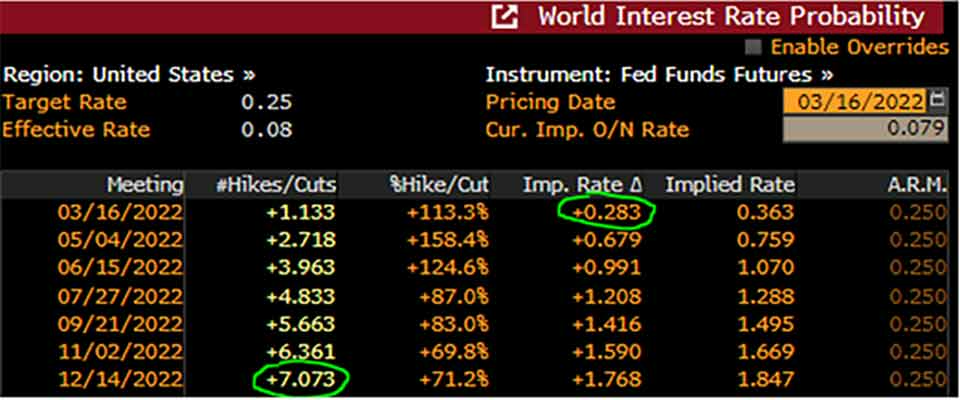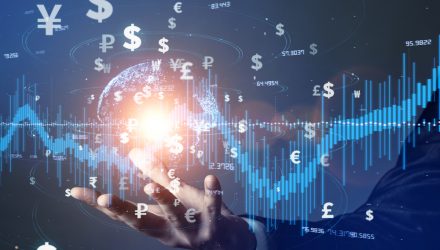Summary
As the market waits for the U.S. Federal Reserve’s “inaugural” rate hike, developments in Russia/Ukraine and China are having a meaningful impact on asset prices.
Russia/Ukraine Negotiations
The rate-setting meeting of the U.S. Federal Reserve (Fed) is supposed to be the event of the day, but one report referred to it as “second fiddle”. And indeed, overnight developments in China and Russia/Ukraine had a meaningful impact on the market. Comments from both Russian and Ukrainian officials about a “realistic approach” to the negotiations sparked hopes for a compromise solution and ceasefire. Ukrainian sovereign bonds staged a huge rally (10-year yield was 298bps tighter at 9:15am ET, according to Bloomberg LP), and all Central European currencies were trading stronger against the U.S. dollar.
China Financial Stability
In China, authorities seem to have had enough “fun” with the latest stock market rout, basically declaring it a threat to financial stability. A statement released after a special meeting hosted by Vice Premier Liu He mentioned “proactive”, “forceful”, and “effective” policies, and said that tech regulations should be “standardized, transparent and predictable”. There have been no concrete policy announcements yet, but the proclamation was enough to send the Hang Seng TECH Index1up by 22% in the morning trade.
EM and Fed Rate Hikes
Circling back to our original question whether the Fed is overrated, we’ll find out this afternoon. Fed Funds Futures are pricing in 28bps of tightening, which implies a small probability of a larger 50bps rate hike. The market is also expecting a total of seven Fed hikes this year (see chart below). The statement and the press conference will be closely watched in emerging markets (EM), many of which (a) are going through yet another inflationary wave and (b) have already frontloaded a lot of tightening. Brazil is one of these countries. It is expected to hike by 100bps this afternoon, and the local swap curve is pricing in another hike of a similar magnitude in May. Stay tuned!

1The Hang Seng TECH Index tracks the 30 largest technology companies listed in Hong Kong.
PMI – Purchasing Managers’ Index: economic indicators derived from monthly surveys of private sector companies. A reading above 50 indicates expansion, and a reading below 50 indicates contraction; ISM – Institute for Supply Management PMI: ISM releases an index based on more than 400 purchasing and supply managers surveys; both in the manufacturing and non-manufacturing industries; CPI – Consumer Price Index: an index of the variation in prices paid by typical consumers for retail goods and other items; PPI – Producer Price Index: a family of indexes that measures the average change in selling prices received by domestic producers of goods and services over time; PCE inflation – Personal Consumption Expenditures Price Index: one measure of U.S. inflation, tracking the change in prices of goods and services purchased by consumers throughout the economy; MSCI – Morgan Stanley Capital International: an American provider of equity, fixed income, hedge fund stock market indexes, and equity portfolio analysis tools; VIX – CBOE Volatility Index: an index created by the Chicago Board Options Exchange (CBOE), which shows the market’s expectation of 30-day volatility. It is constructed using the implied volatilities on S&P 500 index options.; GBI-EM – JP Morgan’s Government Bond Index – Emerging Markets: comprehensive emerging market debt benchmarks that track local currency bonds issued by Emerging market governments; EMBI – JP Morgan’s Emerging Market Bond Index: JP Morgan’s index of dollar-denominated sovereign bonds issued by a selection of emerging market countries; EMBIG – JP Morgan’s Emerging Market Bond Index Global: tracks total returns for traded external debt instruments in emerging markets.
The information presented does not involve the rendering of personalized investment, financial, legal, or tax advice. This is not an offer to buy or sell, or a solicitation of any offer to buy or sell any of the securities mentioned herein. Certain statements contained herein may constitute projections, forecasts and other forward looking statements, which do not reflect actual results. Certain information may be provided by third-party sources and, although believed to be reliable, it has not been independently verified and its accuracy or completeness cannot be guaranteed. Any opinions, projections, forecasts, and forward-looking statements presented herein are valid as the date of this communication and are subject to change. The information herein represents the opinion of the author(s), but not necessarily those of VanEck.
Investing in international markets carries risks such as currency fluctuation, regulatory risks, economic and political instability. Emerging markets involve heightened risks related to the same factors as well as increased volatility, lower trading volume, and less liquidity. Emerging markets can have greater custodial and operational risks, and less developed legal and accounting systems than developed markets.
All investing is subject to risk, including the possible loss of the money you invest. As with any investment strategy, there is no guarantee that investment objectives will be met and investors may lose money. Diversification does not ensure a profit or protect against a loss in a declining market. Past performance is no guarantee of future performance.







